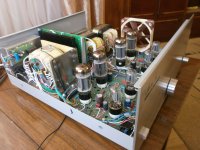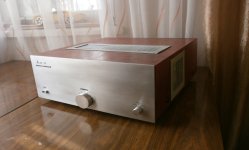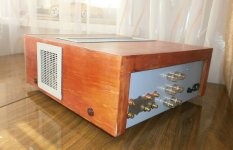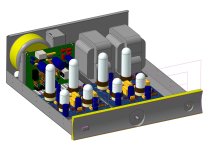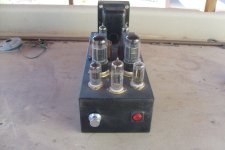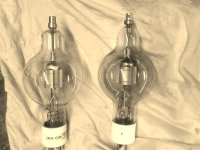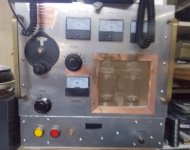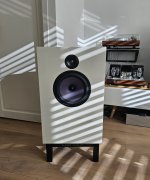Yes, I think I have some of those too in my collection. I picked the PE06/40Ns because of their black sockets, most other 807s have brown sockets.you may also try 5933....
you mean base? yes the 5933 is brown based.. at east the ones i have..Yes, I think I have some of those too in my collection. I picked the PE06/40Ns because of their black sockets, most other 807s have brown sockets.
Last edited:
that is because it is a 5-pin tube, but kt88;s also have large bases..Base, sorry. Yes, and my 5933WA(?)s have unusually large bases.
Is that fan sucking air out from chassis, or blowing in?I want to show one of my latest works with tube EL34
Sucking air out from chassis. Using a silent fan Nuctua-S12A ULN.
https://noctua.at/en/nf-s12a-uln
I have a lot of tubes and Iron along with plenty of components. The input is a 12BZ7 and half of the 12AU7's are used as followers into a 12AU7 Cathodyne. The output tubes are 6BL7's. I use 2 rectifiers( 6X4's) split so I effectively have 2 power supplies. The other version uses 6X5GT's for the rectifiers. I really like this little amp. The highs and mids are really clear and present with no harsh edges and it will reach down in the bottom just fine. I actually have 7 amps within reach of my computer. I like to build. I will post more pictures as I can. Another favorite is my SE EL34 with a 6SN7 input and a 5R4WGBY rectifier. That amp can be switched between Pentode and quasi Triode mode. Any amp I build that has multi-grid output tube, I always make it switchable. Another one I really like for it's size is a 6CG7 input/follower going to 1 of 3 tubes. 6K6GT, 6Y6GT and 6W6GT. It could also use a 6V6 but, I really don't like that tube. I am retired, a Widower and I live alone so, my time is my own and I have collected a lot of stuff. When I get a whim , I act on it. I keep looking at this matched pair of 100th tubes and I really want to build an amp with them. The only issue with that is for those I would have to buy a set of output transformers and I still have 2 other amp projects with chassis cut and all major components mounted. I guess I will finish those first..
Regards,
Jamie
Regards,
Jamie
Attachments
Jamiemunz,
Are those Transmitter Triodes?
Check out Shishido's unique circuit, that uses a single ended non-air-gapped interstage transformer.
The driver current of the driver tube's primary current x the primary turns is the same as the output tubes quiescent grid current x the secondary turns.
A lot of Transmitting Triodes work best with quiescent grid current.
With the two DC currents in opposite directions, there is no quiescent magnetic field in the interstage transformer, so there does not need to be any air gap. That makes it easier to use smaller laminations, tigher coupled primary to secondary, less turns, and lower leakage inductance from primary to secondary.
Are those Transmitter Triodes?
Check out Shishido's unique circuit, that uses a single ended non-air-gapped interstage transformer.
The driver current of the driver tube's primary current x the primary turns is the same as the output tubes quiescent grid current x the secondary turns.
A lot of Transmitting Triodes work best with quiescent grid current.
With the two DC currents in opposite directions, there is no quiescent magnetic field in the interstage transformer, so there does not need to be any air gap. That makes it easier to use smaller laminations, tigher coupled primary to secondary, less turns, and lower leakage inductance from primary to secondary.
I have seen a design using these tubes.One of the biggest issues with these tube in Class A SE is that you have to have a high voltage. Like at least 2000 Volts. If you look at the curves when the B+ starts to approach 1000 V the tube will not even turn on without a positive bias on the grid. And then there is the problem of getting a transformer made. The breakdown voltage has to be close to 4000 V in order to survive that high a B+ and since Peter Dauhl is no longer around, I don't know where to find one and I draw the line at winding my own transformers. I will check out Shishido's work. The other real big issue I have with these tubes in a Home audio amp is although I live alone, I do have cats around the house so I would , at the least, have to encase the amp in glass. I have a number of Linear Amplifiers I have build for my HAM Radio station but, that's easy. You want a R.F. amplifier to be shielded. The picture is the Little amp. That's a pair of 813's running at a little over 1850 Volts. It does a cool 850 Watts output. That's just the RF deck. The power supply is on the floor and weighs over 100 pounds. Again, that's the Little amp. The BIG amp is a pair of 4-1000's running at a B+of over 4000V. The output is over 3KW. Yes, that is over the legal limit but, it wasn't at the time it was built and actually there was a reason it had to be powerful. I was into a form of communications known as SSTV or Slow Scan Television. It is a 50% duty cycle mode of operation. So, in order to send signals around the World at legal limit, it had to be able to do twice the power to run sustained legal output.
BTW: I would like to apologize for my comment about the Tek scope post. Now what I said about the scope operation was totally correct but, I got a little defensive. I can only blame it on a lapse in judgement.
So, I do have to ask about your handle. Do you actually have an amp running 6A3's? I good buddy of mine and he is a builder as well has a very nice P P 6A3 amp and it really does sound awesome!!
You would probably like my work and test bench. Although all the equipment is older, I maintain and calibrate all of it. Let me clean up the bench and I will snap a picture and share it. Anyway, I look forward to chatting some more.
Best Regards,
Jamie
BTW: I would like to apologize for my comment about the Tek scope post. Now what I said about the scope operation was totally correct but, I got a little defensive. I can only blame it on a lapse in judgement.
So, I do have to ask about your handle. Do you actually have an amp running 6A3's? I good buddy of mine and he is a builder as well has a very nice P P 6A3 amp and it really does sound awesome!!
You would probably like my work and test bench. Although all the equipment is older, I maintain and calibrate all of it. Let me clean up the bench and I will snap a picture and share it. Anyway, I look forward to chatting some more.
Best Regards,
Jamie
Attachments
Jamiemunz,
I used to design and build single ended amplifiers, sometimes stereo, mostly mono-blocks on small chassis.
Having already used 2A3, 45, and 300B for those amplifiers, I wanted to try the 6A3.
My first post on diyAudio was a single ended 6A3 amplifier. That was the origin of the name I picked.
I still have a pair of 6A3s, but they are in their boxes, instead of in amplifiers.
Older test equipment is great.
I love working with others at their home benches.
For my 8th grade science project, I built the CRT AM modulation monitor (Trapezoid pattern), right out of the ARRL amateurs handbook.
Without an AM transmitter, all I could show was deflection from the vertical and horizontal position pots, the intensity pot, focus pot, and . . .
deflection from a cow magnet.
My first calibrated electronic measurement, 9th grade, was a simple germanium diode crystal set that drove a germanium bipolar transistor for amplification. I used a very nice 0-1mA meter movement to measure the transistor current.
Yes, let's continue to post back and forth.
I am somewhat like you; You grew up in electronics tinkering, building, studying, working electronics jobs, and as a radio amateur, am I right?
For me, 3 local radio clubs that were going to teach me morse code (sounds, heard; not dot and dash symbols) all gave up teaching us club members and students. Back then, it was either Novice Class at 5 words per minute and HF bands; or no code, but Technician Class restricted to VHF.
So I never got my Amateur license, and I tinkered in other electronics devices and subjects. But as an electronic technician for the communication gear on a US destroyer, I had plenty of beginning RF practical experience. I had other government RF jobs, then shipyards naval electronics; ultrasound dopplers at RF frequencies, test and measurement including regular and real time spectrum analyzers, vector network analyzers, and other such jobs.
I used to design and build single ended amplifiers, sometimes stereo, mostly mono-blocks on small chassis.
Having already used 2A3, 45, and 300B for those amplifiers, I wanted to try the 6A3.
My first post on diyAudio was a single ended 6A3 amplifier. That was the origin of the name I picked.
I still have a pair of 6A3s, but they are in their boxes, instead of in amplifiers.
Older test equipment is great.
I love working with others at their home benches.
For my 8th grade science project, I built the CRT AM modulation monitor (Trapezoid pattern), right out of the ARRL amateurs handbook.
Without an AM transmitter, all I could show was deflection from the vertical and horizontal position pots, the intensity pot, focus pot, and . . .
deflection from a cow magnet.
My first calibrated electronic measurement, 9th grade, was a simple germanium diode crystal set that drove a germanium bipolar transistor for amplification. I used a very nice 0-1mA meter movement to measure the transistor current.
Yes, let's continue to post back and forth.
I am somewhat like you; You grew up in electronics tinkering, building, studying, working electronics jobs, and as a radio amateur, am I right?
For me, 3 local radio clubs that were going to teach me morse code (sounds, heard; not dot and dash symbols) all gave up teaching us club members and students. Back then, it was either Novice Class at 5 words per minute and HF bands; or no code, but Technician Class restricted to VHF.
So I never got my Amateur license, and I tinkered in other electronics devices and subjects. But as an electronic technician for the communication gear on a US destroyer, I had plenty of beginning RF practical experience. I had other government RF jobs, then shipyards naval electronics; ultrasound dopplers at RF frequencies, test and measurement including regular and real time spectrum analyzers, vector network analyzers, and other such jobs.
Last edited:
https://www.hammfg.com/electronics/transformers/classic/pwdahlThe breakdown voltage has to be close to 4000 V in order to survive that high a B+ and since Peter Dauhl is no longer around, I don't know where to find one and I draw the line at winding my own transformers.
Buddy, you were spot on about me. When I saw my Music teachers station, I was hooked. Especially when I asked could I become a radio amateur and he said yes. Told me about CW and I had to pass a 5WPM test for the Novice and then there was a written test. He handed me the ARRL License manual and a Code Practice oscillator. I went home, looked at the page in the manual with the CW characters on it. I noticed right away that the most used characters were the shortest and the least, the longest. After a while my Father came in the room to see what I was doing. I am learning Morse code Dad. I am going to become a HAM Radio operator. I was ready in 4 months and Mr. Scales( my Music teacher actual real last name) took me to a HAM friends house to take the test. He didn't want anyone to say I was favored or passed without testing. It was a long process back then. I had to pass Morse and then Herb my examiner had to send my app in and we waited for the test to arrive. $ weeks!!! Herb checked it over and let me know I passed but, I still had to wait for the test to get to the FCC and wait for them to send me my ticket. 6 Weeks. When it finally arrived, I got home from school and there was my envelope. Ripped it open and there was my call. WN7GMN ... Not bad it has a good rhythm. Into the bedroom. FIred up my rig sent CQ and listened. I had been so excited I was sending at around 15 WPM and at first I couldn't make out anything because there was around 15 stations calling me. and it was just noise!! a KID FROM SCHOOL CALLED ON THE PHONE AND asked if that was me on 40. Yes. Why aren't you answering them. Too noisy! Slow down try again. Finally WN5RCN called. Sante Fe New Mexico. We talked for over an hour and when he signed, I heard my call.. What?? From a WA0ALX. Wait a minute, he's a General. Again, we talked for an hour. He had been reading the mail and noticed that The NM station was my first contact. he welcomed me and complemented me on my fist. After that, I shut down. Hungry and tired I ate dinner and fell asleep. Every day I was making contacts and my speed was improving.. Mr. Scales gave me a Codamatic CW teaching machine paper tapes and nothing but letter groups with numbers and punctuation thrown in from time to time. So I got my General a few months before my 12th Birthday. My first station was a Hallicrafters SX-71 and I Heathkit AT-1 to an inverted Vee. On 40 it would put out around 18 Watts and on 15 Meters less than 12 Watts but, I started getting more interested in 15 because in the late afternoon to early evening, I could hear and work. I fixed a lot of radios, tape recorders. I save over $50 and it was time for a better transmitter. A kid I knew from Church told me his had use to be a HAM and he still had one of his old transmitters. I got that rig. It was a Globe Scout and put out 45 to 50 Watts., Anyway enough of that for now. I am going to tell you a bit more and then I have to take care of some things here at the house. I met a lot of really interesting people through HAM Radio. King Hussein of Jordan when he was alive , Donnie Osmond, Rahleen Christian( Great Gran Daughter 4 generations removed of Fletcher Christian from Mutiny on the Bounty) and one of my favorites... Joe Walsch. I almost got in a fist fight with Joe over antennas... I'll tell you more later. It is good to meet you. Regards, JamieJamiemunz,
I used to design and build single ended amplifiers, sometimes stereo, mostly mono-blocks on small chassis.
Having already used 2A3, 45, and 300B for those amplifiers, I wanted to try the 6A3.
My first post on diyAudio was a single ended 6A3 amplifier. That was the origin of the name I picked.
I still have a pair of 6A3s, but they are in their boxes, instead of in amplifiers.
Older test equipment is great.
I love working with others at their home benches.
For my 8th grade science project, I built the CRT AM modulation monitor (Trapezoid pattern), right out of the ARRL amateurs handbook.
Without an AM transmitter, all I could show was deflection from the vertical and horizontal position pots, the intensity pot, focus pot, and . . .
deflection from a cow magnet.
My first calibrated electronic measurement, 9th grade, was a simple germanium diode crystal set that drove a germanium bipolar transistor for amplification. I used a very nice 0-1mA meter movement to measure the transistor current.
Yes, let's continue to post back and forth.
I am somewhat like you; You grew up in electronics tinkering, building, studying, working electronics jobs, and as a radio amateur, am I right?
For me, 3 local radio clubs that were going to teach me morse code (sounds, heard; not dot and dash symbols) all gave up teaching us club members and students. Back then, it was either Novice Class at 5 words per minute and HF bands; or no code, but Technician Class restricted to VHF.
So I never got my Amateur license, and I tinkered in other electronics devices and subjects. But as an electronic technician for the communication gear on a US destroyer, I had plenty of beginning RF practical experience. I had other government RF jobs, then shipyards naval electronics; ultrasound dopplers at RF frequencies, test and measurement including regular and real time spectrum analyzers, vector network analyzers, and other such jobs.
You see it's only Peter Dahl in name these days. In the late 90's you could talk to him on the phone about what you needed and he would make it at a reasonable price. Now it's all just cookie cutter transformers from Peter's records. Thanks for posting that though.. Regards, Jamie
- Home
- Amplifiers
- Tubes / Valves
- Photo Gallery
